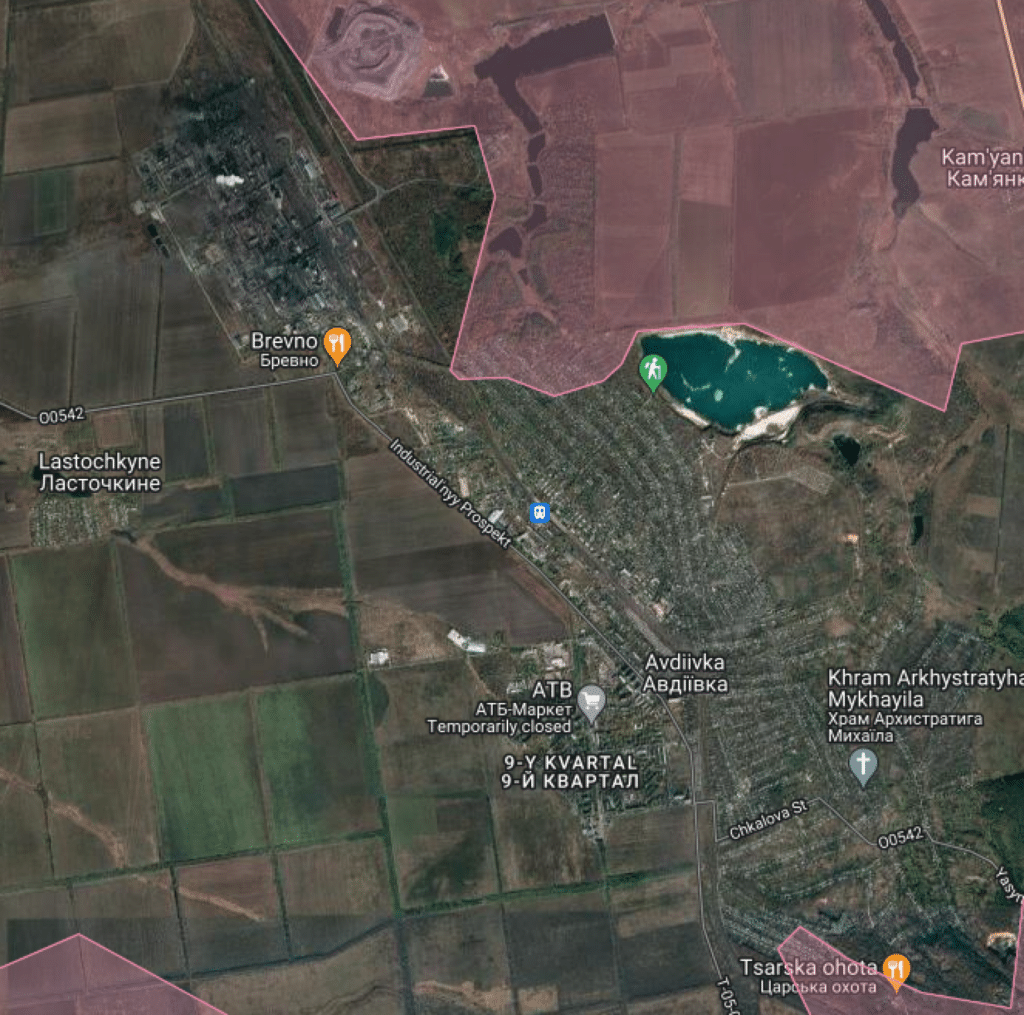February 8, 2024 | FDD's Long War Journal
Ukraine’s Hold on Avdiivka Slipping
February 8, 2024 | FDD's Long War Journal
Ukraine’s Hold on Avdiivka Slipping
A Ukrainian military spokesman confirmed today that Russian troops have pressed into northern Avdiivka, a small city in southeastern Ukraine that has been on the front line since 2014. While Avdiivka will likely fall, Russia currently has little prospect of exploiting that success. That could change, however, if Congress does not pass more aid for Ukraine.
Russian Gains in Avdiivka
On February 4, the Ukrainian war correspondents Yuriy Butusov and Andriy Tsaplienko reported that Russian forces had entrenched themselves in buildings in northern Avdiivka. Tsaplienko said the Russians had exploited cloudy weather that impeded Ukrainian drone reconnaissance. The Russian troops bypassed the Avdiivka Coke and Chemical Plant, a key defensive stronghold located at the northwest end of the city. They evidently aim to block Ukraine’s main supply route (and only paved road) into Avdiivka, the 00542 road, which connects to the city from the northwest.
On Feb 5, Butusov and a usually reliable Ukrainian Telegram channel reported that Russian troops were around a kilometer from the mouth of the road. As of February 7, the Russians had consolidated their positions and were attempting to push deeper, according to the Ukrainian channel. Today, a spokesman from Ukraine’s “Tavria” Operational-Strategic Grouping of Troops, whose area of operations includes Avdiivka, confirmed that Russian forces had pressed beyond the houses on Adviivka’s northern outskirts and into the city itself.

Estimation of Russian advances in Avdiivka as of February 8, 2024, based on Ukrainian reports and other open-source information.
Avdiivka Recap
Russia launched an operation to take Avdiivka back in October. A sizable mechanized force, which included Central Military District units redeployed from northeastern Ukraine, attempted to envelop the city and sever its supply routes. Yet this effort achieved little despite heavy losses, including hundreds of vehicles.
Ukrainian mines, artillery fire (including with U.S.-provided cluster munitions), and first-person view (FPV) attack drones decimated the attacking Russian columns. Russian observers complained of insufficient counter-battery fire and shoddy coordination between Russian units, which these days are manned in large part by poorly trained mobilized personnel.
Ukraine redeployed additional forces to shore up Avdiivka’s defense, including several mechanized brigades that had participated in Kyiv’s unsuccessful 2023 counteroffensive. Russia shifted tactics, relying mainly on small-unit assaults by dismounted infantry. Over months of attritional fighting, Russian troops inched forward at Avdiivka’s northern flank but also began trying to press directly into the city itself. In January, the Russians achieved a minor breakthrough at Avdiivka’s southern outskirts, although the situation stabilized following Ukrainian counterattacks.
Now, however, Avdiivka’s fall seems like a matter of when, not if. “While for several weeks we were saying the situation was very difficult but under control, now the situation is very difficult and in some places critical,” Avdiivka’s mayor acknowledged yesterday.
Ukraine Short on Men and Materiel
Although Russia has likely taken far heavier casualties at Avdiivka than Ukraine, a dearth of infantry makes it difficult for Ukrainian forces there to replace losses and rotate personnel. Ukraine’s artillery units, meanwhile, suffer from “shell hunger,” exacerbated by the suspension of U.S. aid commitments in late December. By contrast, Moscow has received a large amount of ammunition from North Korea, providing Russian forces with a considerable quantitative advantage in artillery fire.
Ukraine’s shell shortage has forced it to rely more on FPV drones as a partial replacement for artillery. Russia has reportedly responded by hunting for Ukrainian drone operators in the Avdiivka area, targeting their positions with bombs and artillery.
As in Bakhmut last year, heavy Russian artillery fire and bombing steadily destroy buildings used as defensive positions, eventually allowing Russian infantry to seize the rubble. Ukrainian sources say Russia has dropped hundreds of guided bombs on Avdiivka in 2024 alone — more than during all of last year, according to Ukrainian officials. According to Avdiivka’s mayor, Russia has also stepped up its bombardment of the city’s main supply route in recent weeks, using guided bombs in addition to FPV drones.
Most of these bombs are “dumb” munitions retrofitted with UMPK add-on kits, which turn them into guided glide bombs that can be launched from stand-off range. Introduced last year, the UMPK has allowed Russia’s Air Force to play a greater role than it could earlier in the war. Russia may have increased UMPK production in recent months. Russia has also begun using these kits with more types of bombs, including cluster munitions and powerful 1500-kilogram bombs.
Implications of Avdiivka’s Fall
Russia’s progress in Avdiivka follows minor Russian advances elsewhere on the eastern front in recent weeks. But while the Russians have regained the initiative in most areas, Ukrainian forces will likely manage to prevent major Russian gains so long as Washington provides Kyiv with even relatively modest amounts of military aid this year.
In theory, Moscow’s forces could exploit Avdiivka’s fall to drive deeper into Donetsk Oblast, perhaps toward the city of Pokrovsk, an important logistical hub. This would go a long way toward achieving Vladimir Putin’s goal of taking the rest of the Donbas region.
As things stand now, though, Avdiivka’s fall would likely just flatten the front line while providing some breathing room for Russian logistics in nearby Donetsk city. Having taken heavy losses among its junior officer corps and professional enlisted troops, Russia’s military appears unable to execute a large-scale offensive against a stubborn Ukrainian defense. Moscow’s penchant for premature offensives further undercuts its ability to rebuild force quality. And despite its increasing domestic shell production and supplies from abroad, Russia cannot replicate the crushing fire superiority its forces enjoyed during their 2022 Donbas offensive.
If Congress does not pass further aid, however, the next year will look much darker for Ukraine.
John Hardie is the deputy director of FDD’s Russia Program and a contributor to FDD’s Long War Journal.